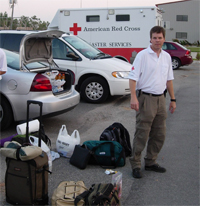Kellogg Schwab: Assessing the Aftermath of Hurricane Katrina
Four days after Hurricane Katrina devastated the U.S. Gulf Coast, Kellogg Schwab, PhD, was on a plane to Alabama, sent there by the American Red Cross to assist with the assessment of shelters in the region. Schwab, an assistant professor and co-director of the Bloomberg School’s Center for Water and Health, was part of four-person team of medical and public health experts, led by W. Courtland Robinson, PhD, assistant professor with the School’s Center for Refugee and Disaster Response. They made their way from Alabama to the Mississippi coastline, an area struck by the eye of Hurricane Katrina.

Kellogg Schwab unloads gear at Red Cross shelter
“As we started going down toward the area, there was an obvious lack of infrastructure as it was devastated from the hurricane,” said Schwab. “Telephone wires were down—all the phone systems were intermittent at best.” He added, “There was no power at some of these shelters. It was very hot and it was very dark, because there was no power in the cities surrounding these areas. But people were coping for the most part. They were getting food and getting water to drink.”

Downed trees line route to Mississippi shelter
According to Schwab, the lack of communication made it difficult for relief workers to get needed supplies and services to the shelters. However, most of the shelters they surveyed along the Mississippi coast had bottled water and food he said. Medical personnel were able treat the sick and injured, but medications for diabetes and high blood pressure were still needed for people with underlying chronic conditions. A few shelter clients were suffering withdrawal from alcohol or drugs, said Schwab. He added, “The people were resilient. They were coping very well under very extreme conditions.”
While bottled water was available for drinking, safe waste water disposal remained an issue. Some shelters did not have running water and had to rely on portable toilets, Schwab said. Other shelters had running water, but there was no equipment to determine if the water was safe for drinking or showering.
“If piped water has lost pressure as when the pumps are shut off, this can cause the potential for having contaminants in your water supply,” said Schwab. “Showering in it, using it for washing your hands—that’s something people should be made aware of—that this is a potentially compromised system.”--Tim Parsons
Public Affairs media contacts for the Johns Hopkins Bloomberg School of Public Health: Tim Parsons or Kenna Lowe at 410-955-6878 or paffairs@jhsph.edu.
